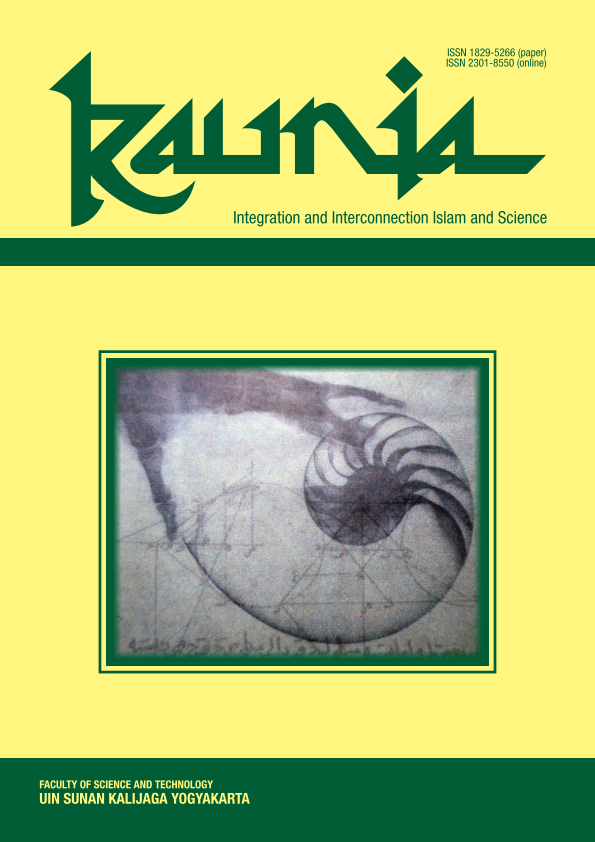The Effect of Initial Intensity of Light Sources on the Fraunhofer Diffraction Pattern for Circular Apperture Using the Gauss-Legendre 4 Point Quadrature Integration Numerical Method: Scientific and Islamic Integration-Interconnection
DOI:
https://doi.org/10.14421/kaunia.2083Keywords:
Fraunhofer diffraction, Gauss-Legendre 4 pointAbstract
Visualization of Fraunhofer diffraction pattern of circular apperture has been obtained using the 4 point Gauss-Legendre Quadrature integration method. The 4 point Gauss-Legendre quadrature integration method is used to solve the integral function of intensity. The intensity function is used to display the intensity distribution of the Fraunhofer diffraction pattern of circular apperture in a visual form through a computer programming simulation based on GUI (Graphycal User Interface) MATLAB. Simulation results show changes in initial intensity affect diffraction patterns.References
Brand, J. C. D. 1995. Lines of Light: The Sources of Dispersive Spectroscopy, 1800–1930. CRC Press. ISBN 978-2-88449-163-1.
Bruno, T. J. dan Svoronos, P. D. N. 2006. Handbook of Fundamental Spectroscopic Correlation Charts. CRC Press. ISBN 0-8493-3250-8.
Dermawan, R. 2016. Perbandingan Metode Gauss Legendre, Gauss Lobatto dan Gauss Kronrod Pada Integrasi Numerik Fungsi Eksponensial. Jurnal Matematika dan Pendidikan Matematika, Vol. I No. 2.
Firausi, K.S., Sutini, dan Setiabudi, W. 2003. Difraksi Fraunhofer Sebagai Metode Alternatif Sederhana Spektrum. Berkala Fisika, Vol 6. No.1 Hal 1-4. ISSN 1410-9662.
Halliday, D., dan Resnick, R. 2015. Fundamental of Physics (10th ed). Wiley, ISBN 978-1-118-23072-5.
Hecth, E. 2002. Optics (4th ed). Addison-Wesley Publishing Company. Canada.
Jenkins, F.A., dan White, H.E. 2001, Fundamentals of Optics (4th ed). McGraw-Hill International Book Company. Tokyo. ISBN 0-07-256191-2.
Munir, R. 2010. Metode Numerik. Informatika Bandung. Bandung.
Prasetia, A. 2016. Performansi Metode Trapesium Dan Metode Gauss-Legendre dalam Penyelesaian Integral Tertentu Berbantuan Matlab. Jurnal Mercumatika, Vol. 1 No. 1 ISSN: 2548-1819.
Starr, C. 2005. Biology: Concepts and Applications. Thomson Brooks/Cole. ISBN 978-0-534-46226-0.
Scheid, F. 1968. Numerical Analysis (2nd ed). McGraw-Hill. ISBN 07-055197-9.
Tim Penerjemah. 2004. Al-Qur’an dan Terjemahannya. Jakarta: Departemen Agama RI.
Tipler, P. A dan Mosca, G. 2004. Physic for Scientist and Engineers (5th ed). W.H, Freeman and Company. Newyork. ISBN: 0-7167-4389-2.
Widagda, I. G. A. 2015. Simulasi Intensitas Difraksi Pada Celah Lingkaran (Circuler Aperture) dengan Metode Simpson, Jurnal Universitas Udayana.
Yanuarif, C. 2016. Simulasi Pola Difraksi Fraunhofer untuk Celah Lingkaran dengan Modifikasi Fungsi Bessel. Jurnal Integrated Lab UIN Sunan Kalijaga, Vol. 4 No. 2. ISSN 2339-0905.
Zhang, Z., Bai, H.,Yang, G., Jiang, F., Ren, Y., Li, J., Yang, K., dan Yang, H. 2013. Computer Simulation of Fraunhofer Diffraction Based on MATLAB. Optik, Vol. 124 Issue 20 Pages 4449-4451. ISSN 0030-4026.
Downloads
Published
How to Cite
Issue
Section
License
All articles published in Kaunia are licensed under a Creative Commons Attribution-NonCommercial-ShareAlike 4.0 International license, with the copyright to these articles held by the journal. Anyone is free to read, download, copy, distribute, print, search, link to full text articles, or transform an article, in any medium or format, provided they do so non-commercially, give appropriate credit to Kaunia, and distribute any derivative work under the same (or equivalent) terms.
By submitting to Kaunia, authors agree to both the terms of the CC BY-NC-SA license and the automatic transfer of the copyright to their article if it is accepted.









